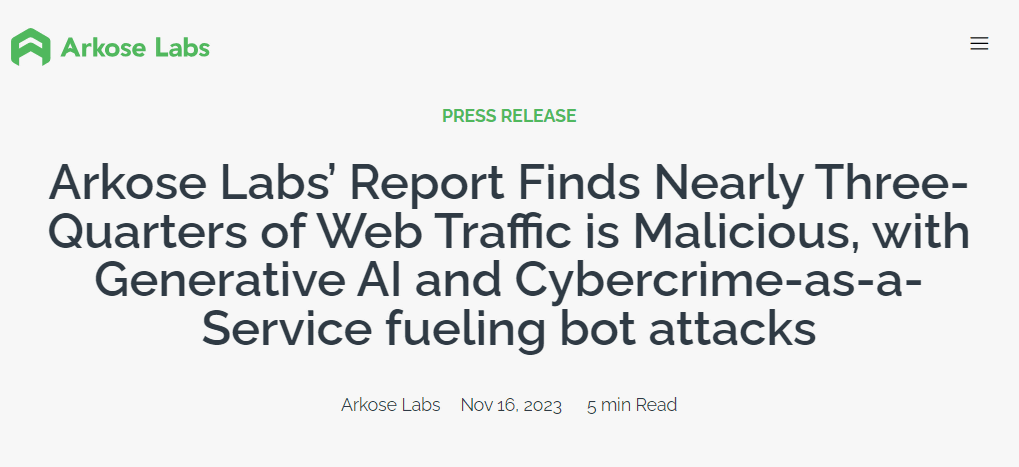More than 70% of internet traffic is used by bad bots and scams

While some bots that programmatically operate on the Internet can be useful, such as indexing the Internet, most are designed for malicious purposes. According to security firm Arkose Labs, 73% of internet traffic is made up of malicious bots and
Arkose Labs' Report Finds Nearly Three-Quarters of Web Traffic is Malicious, with Generative AI and Cybercrime-as-a-Service fueling bot attacks | Arkose Labs
https://www.arkoselabs.com/latest-news/arkose-labs-report-finds-nearly-three-quarters-web-traffic-malicious-generative-ai-cybercrime-as-a-service-fueling-bot- attacks/

Bad Bots Account for 73% of Internet Traffic: Analysis - SecurityWeek
https://www.securityweek.com/bad-bots-account-for-73-of-internet-traffic-analysis/
The top five security attacks using bots are ``creation of fake accounts,'' ``account takeover,'' ``scraping,'' ``account management,'' and ``unauthorized use of products and services.'' The attacks that increased the most from January to September 2023 were SMS fraud, which increased by 2141%, followed by account management, which increased by 160%, and fake account creation, which increased by 23%.
The top five industries targeted are technology companies, gaming companies, social media, e-commerce, and financial services. From January to June 2023, the number of uses of 'intelligent bots' that use advanced technologies such as machine learning and AI to imitate human behavior and avoid detection has increased approximately four times. thing. Arkose Labs predicts that malicious bots will continue to become more prevalent due to the rise of artificial intelligence and the increasing professionalism of criminals.
Additionally, with the rise of AI, the number of scraping bots that collect data and images from websites has increased dramatically, increasing by 432% from January to June 2023. Arkose Labs says, ``It must be said that scraping is a legally gray area,'' but it is definitely immoral if it violates the terms of use published by the website. Masu.

Furthermore, there is an increasing number of ``click farms'' that employ large numbers of people instead of bots at low wages to create fake accounts and clear CAPTCHAs at low cost. In the first half of 2023 alone, there will be more than 3 billion attacks related to click farms, mainly in Brazil, India, Russia, Vietnam, and the Philippines.
In addition, Arkose Labs points out that a business model called Cybercrime-as-a-Service (CaaS) is lowering the hurdles for committing cybercrime. CaaS is a service that packages the tools necessary to carry out a cyber attack and pays for only the number of times they are used. For example, CaaS providers provide tools to infiltrate ransomware into targets, and users of the tools can distribute the ransom and other profits obtained by using the tools to the CaaS provider.
'The massive rise of CaaS has completely changed the economic landscape for cybercriminals,' said Kevin Goshak, CEO of Arkose Labs. 'In the future, cybercrime will be more effective because it is a development company rather than just an individual cybercriminal.'

Related Posts:
in Security, Posted by log1i_yk







